PA6 and Halloysite Nanotubes Composites with Improved Hydrothermal Ageing Resistance: Role of Filler Physicochemical Properties, Functionalization and Dispersion Technique
Abstract
:1. Introduction
2. Materials and Methods
2.1. Materials
2.2. HNT Functionalization
2.3. HNT Characterization
2.4. PA6 and HNT Nanocomposites (PA6_HNT) Preparation and Characterization
2.4.1. In Situ Polymerization
2.4.2. Melt Processing
2.4.3. PA6 Nanocomposites Characterization
2.5. Hydrothermal Ageing Tests
3. Results and Discussion
3.1. HNT Characterization and Functionalization
3.2. Synthesis of PA6 and PA6-HNT Nanocomposites via In Situ Polymerization and Melt Blending Processes
3.3. Isothermal Crystallization Behavior of PA6 Nanocomposites
3.4. Non-Isothermal Crystallization Behavior of PA6 Nanocomposites
3.5. Water Uptake and Rheological, SEC and DSC Characterization of Aged Nanocomposites
- −
- PA6in situ_HNTH_4_APTES: χc_unaged: 14.0% vs. χc_aged: 13.3%
- −
- PA6in situ_HNTS_4_APTES: χc_unaged: 14.9% vs. χc_aged: 14.9%
- −
- PA6melt_HNTH_4_APTES: χc_unaged: 21.7% vs. χc_aged: 21.1%
- −
- PA6melt_HNTS_4_APTES: χc_unaged: 19.3% vs. χc_aged: 20.3%.
4. Conclusions
Supplementary Materials
Author Contributions
Funding
Acknowledgments
Conflicts of Interest
References
- Jacob, A. Carbon fibre and cars—2013 in review. Reinf. Plast. 2014, 58, 18–19. [Google Scholar] [CrossRef]
- Stewart, R. Rebounding automotive industry welcome news for FRP. Reinf. Plast. 2011, 55, 38–44. [Google Scholar] [CrossRef]
- Horrocks, A.R.; Kandola, B.K.; Davies, P.J.; Zhang, S.; Padbury, S.A. Developments in flame retardant textiles—A review. Polym. Degrad. Stab. 2005, 88, 3–12. [Google Scholar] [CrossRef]
- Dong, W.; Gijsman, P. Influence of temperature on the thermo-oxidative degradation of polyamide 6 films. Polym. Degrad. Stab. 2010, 95, 1054–1062. [Google Scholar] [CrossRef]
- Gijsman, P.; Meijers, G.; Vitarelli, G. Comparison of the UV-degradation chemistry of polypropylene, polyethylene, polyamide 6 and polybutylene terephthalate. Polym. Degrad. Stab. 1999, 65, 433–441. [Google Scholar] [CrossRef]
- Forsström, D.; Terselius, B. Thermo oxidative stability of polyamide 6 films I. Mechanical and chemical characterisation. Polym. Degrad. Stab. 2000, 67, 69–78. [Google Scholar] [CrossRef]
- Ksouri, I.; De Almeida, O.; Haddar, N. Long term ageing of polyamide 6 and polyamide 6 reinforced with 30% of glass fibers: Physicochemical, mechanical and morphological characterization. J. Polym. Res. 2017, 24, 133. [Google Scholar] [CrossRef]
- Lin, S.; Wang, C.; Wang, Y.; Hou, W. Effects of hydrothermal aging on moisture absorption and property prediction of short carbon fiber reinforced polyamide 6 composites. Compos. Part B Eng. 2018, 153, 306–314. [Google Scholar]
- Sabatini, V.; Farina, H.; Basilissi, L.; Di Silvestro, G.; Ortenzi, M.A. The Use of Epoxy Silanes on Montmorillonite: An Effective Way to Improve Thermal and Rheological Properties of PLA/MMT Nanocomposites Obtained via “in Situ” Polymerization. J. Nanomater. 2015, 16, 213. [Google Scholar] [CrossRef] [Green Version]
- Akkapeddi, M.K. Glass fiber reinforced polyamide-6 nanocomposites. Polym. Compos. 2000, 21, 576–585. [Google Scholar] [CrossRef]
- Wu, G.; Li, B.; Jiang, J. Carbon black self-networking induced co-continuity of immiscible polymer blends. Polymer 2010, 51, 2077–2083. [Google Scholar] [CrossRef]
- Uhl, F.M.; Yao, Q.; Nakajima, H.; Manias, E.; Wilkie, C.A. Expandable graphite/polyamide-6 nanocomposites. Polym. Degrad. Stab. 2005, 89, 70–84. [Google Scholar] [CrossRef] [Green Version]
- Yang, F.; Ou, Y.; Yu, Z. Polyamide 6/silica nanocomposites prepared by in situ polymerization. J. Appl. Polym. Sci. 1998, 69, 355–361. [Google Scholar] [CrossRef]
- Xu, Z.; Gao, C. In situ polymerization approach to graphene-reinforced nylon-6 composites. Macromolecules 2010, 43, 6716–6723. [Google Scholar] [CrossRef]
- Pramoda, K.P.; Liu, T. Effect of moisture on the dynamic mechanical relaxation of polyamide-6/clay nanocomposites. J. Polym. Sci. Part B Polym. Phys. 2004, 42, 1823–1830. [Google Scholar] [CrossRef]
- Hassan, A.; Rahman, N.A.; Yahya, R. Moisture absorption effect on thermal, dynamic mechanical and mechanical properties of injection-molded short glass-fiber/polyamide 6,6 composites. Fibers Polym. 2012, 13, 899–906. [Google Scholar] [CrossRef]
- Nazir, M.S.; Mohamad Kassim, M.H.; Mohapatra, L.; Gilani, M.A.; Raza, M.R.; Majeed, K. Characteristic Properties of Nanoclays and Characterization of Nanoparticulates and Nanocomposites. In Nanoclay Reinforced Polymer Composites; Springer: Singapore, 2016; pp. 35–55. ISBN 978-981-10-1952-4. [Google Scholar]
- Basilissi, L.; Silvestro, G.D.; Farina, H.; Ortenzi, M.A. Synthesis and characterization of PLA nanocomposites containing nanosilica modified with different organosilanes I. Effect of the organosilanes on the properties of nanocomposites: Macromolecular, morphological, and rheologic characterization. J. Appl. Polym. Sci. 2013, 128, 1575–1582. [Google Scholar] [CrossRef]
- Kodgire, P.V.; Bhattacharyya, A.R.; Bose, S.; Gupta, N.; Kulkarni, A.R.; Misra, A. Control of multiwall carbon nanotubes dispersion in polyamide6 matrix: An assessment through electrical conductivity. Chem. Phys. Lett. 2006, 432, 480–485. [Google Scholar] [CrossRef]
- Zhang, W.D.; Shen, L.; Phang, I.Y.; Liu, T. Carbon nanotubes reinforced nylon-6 composite prepared by simple melt-compounding. Macromolecules 2004, 37, 256–259. [Google Scholar] [CrossRef]
- Ayatollahi, M.R.; Shadlou, S.; Shokrieh, M.M.; Chitsazzadeh, M. Effect of multi-walled carbon nanotube aspect ratio on mechanical and electrical properties of epoxy-based nanocomposites. Polym. Test. 2011, 30, 548–556. [Google Scholar] [CrossRef]
- Pan, B.; Li, N.; Chu, G.; Wei, F.; Liu, J.; Zhang, J.; Zhang, Y. Tribological investigation of MC PA6 reinforced by boron nitride of single layer. Tribol. Lett. 2014, 54, 161–170. [Google Scholar] [CrossRef]
- Song, W.L.; Wang, P.; Cao, L.; Anderson, A.; Meziani, M.J.; Farr, A.J.; Sun, Y.P. Polymer/boron nitride nanocomposite materials for superior thermal transport performance. Angew. Chem.-Int. Ed. 2012, 51, 6498–6501. [Google Scholar] [CrossRef] [PubMed]
- De Monte, M.; Moosbrugger, E.; Quaresimin, M. Influence of temperature and thickness on the off-axis behaviour of short glass fibre reinforced polyamide 6.6—Cyclic loading. Compos. Part A Appl. Sci. Manuf. 2010, 41, 1368–1379. [Google Scholar] [CrossRef]
- Ozkoc, G.; Bayram, G.; Bayramli, E. Effects of polyamide 6 incorporation to the short glass fiber reinforced ABS composites: An interfacial approach. Polymer 2004, 45, 8957–8966. [Google Scholar] [CrossRef]
- Reynaud, E.; Jouen, T.; Gauthier, C.; Vigier, G.; Varlet, J. Nanofillers in polymeric matrix: A study on silica reinforced PA6. Polymer 2001, 42, 8759–8768. [Google Scholar] [CrossRef]
- Gensler, R.; Gröppel, P.; Muhrer, V.; Müller, N. Application of nanoparticles in polymers for electronics and electrical engineering. Part. Part. Syst. Charact. 2002, 19, 293–299. [Google Scholar] [CrossRef]
- Liu, M.; Jia, Z.; Jia, D.; Zhou, C. Recent Advance in Research on Halloysite Nanotubes-Polymer Nanocomposite. Prog. Polym. Sci. 2014, 39, 1498–1525. [Google Scholar] [CrossRef]
- Lvov, Y.; Wang, W.; Zhang, L.; Fakhrullin, R. Halloysite Clay Nanotubes for Loading and Sustained Release of Functional Compounds. Adv. Mater. 2016, 28, 1227–1250. [Google Scholar] [CrossRef]
- Tarì, G.; Bobos, I.; Gomes, C.S.F.; Ferreira, J.M.F. Modification of surface charge properties during kaolinite to halloysite-7Å transformation. J. Colloid Interface Sci. 1999, 210, 360–366. [Google Scholar] [CrossRef]
- Rawtani, D.; Agrawal, Y.K. Multifarious applications of halloysite nanotubes: A review. Rev. Adv. Mater. Sci. 2012, 30, 282–295. [Google Scholar]
- Shchukin, D.G.; Sukhorukov, G.B.; Price, R.R.; Lvov, Y.M. Halloysite nanotubes as biomimetic nanoreactors. Small 2005, 1, 510–513. [Google Scholar] [CrossRef] [PubMed]
- Guo, B.; Zou, Q.; Lei, Y.; Jia, D. Structure and performance of polyamide 6/halloysite nanotubes nanocomposites. Polym. J. 2009, 41, 835–842. [Google Scholar] [CrossRef] [Green Version]
- Marney, D.C.O.; Russell, L.J.; Wu, D.Y.; Nguyen, T.; Cramm, D.; Rigopoulos, N.; Wright, N.; Greaves, M. The suitability of halloysite nanotubes as a fire retardant for nylon 6. Polym. Degrad. Stab. 2008, 93, 1971–1978. [Google Scholar] [CrossRef]
- Handge, U.A.; Hedicke-Höchstötter, K.; Altstädt, V. Composites of polyamide 6 and silicate nanotubes of the mineral halloysite: Influence of molecular weight on thermal, mechanical and rheological properties. Polymer 2010, 51, 2690–2699. [Google Scholar] [CrossRef]
- Prashantha, K.; Schmitt, H.; Lacrampe, M.F.; Krawczak, P. Mechanical behaviour and essential work of fracture of halloysite nanotubes filled polyamide 6 nanocomposites. Compos. Sci. Technol. 2011, 71, 1859–1866. [Google Scholar] [CrossRef]
- Lecouvet, B.; Gutierrez, J.G.; Sclavons, M.; Bailly, C. Structure-property relationships in polyamide 12/halloysite nanotube nanocomposites. Polym. Degrad. Stab. 2011, 96, 226–235. [Google Scholar] [CrossRef]
- Prashantha, K.; Lacrampe, M.F.; Krawczak, P. Highly dispersed polyamide-11/halloysite nanocomposites: Thermal, rheological, optical, dielectric, and mechanical properties. J. Appl. Polym. Sci. 2013, 130, 313–321. [Google Scholar] [CrossRef]
- Tung, J.; Gupta, R.K.; Simon, G.P.; Edward, G.H.; Bhattacharya, S.N. Rheological and mechanical comparative study of in situ polymerized and melt-blended nylon 6 nanocomposites. Polymer 2005, 46, 10405–10418. [Google Scholar] [CrossRef]
- Bergeret, A.; Ferry, L.; Ienny, P. Influence of the fibre/matrix interface on ageing mechanisms of glass fibre reinforced thermoplastic composites (PA-6,6, PET, PBT) in a hygrothermal environment. Polym. Degrad. Stab. 2009, 94, 1315–1324. [Google Scholar] [CrossRef]
- Bergeret, A.; Pires, I.; Foulc, M.P.; Abadie, B.; Ferry, L.; Crespy, A. The hygrothermal behaviour of glass-fibre-reinforced thermoplastic composites: A prediction of the composite lifetime. Polym. Test. 2001, 20, 753–763. [Google Scholar] [CrossRef]
- Seltzer, R.; Frontini, P.M.; Mai, Y.W. Effect of hygrothermal ageing on morphology and indentation modulus of injection moulded nylon 6/organoclay nanocomposites. Compos. Sci. Technol. 2009, 69, 1093–1100. [Google Scholar] [CrossRef]
- Jacobi, E.; Schuttenberg, H.; Schulz, R.C. A new method for gel permeation chromatography of polyamides. Macromol. Rapid Commun. 1980, 1, 397–402. [Google Scholar] [CrossRef]
- Piao, H. Influence of water absorption on the mechanical properties of discontinuous carbon fiber reinforced polyamide 6. J. Polym. Res. 2019, 44, 353–358. [Google Scholar] [CrossRef]
- Falcón, J.M.; Sawczen, T.; Aoki, I.V. Dodecylamine-Loaded Halloysite Nanocontainers for Active Anticorrosion Coatings. Front. Mater. 2015, 2, 69. [Google Scholar]
- Joussein, E.; Petit, S.; Churchman, J.; Theng, B.; Righi, D.; Delvaux, B. Halloysite clay minerals—A review. Clay Miner. 2005, 40. [Google Scholar] [CrossRef]
- Taroni, T.; Meroni, D.; Fidecka, K.; Maggioni, D.; Longhi, M.; Ardizzone, S. Halloysite nanotubes functionalization with phosphonic acids: Role of surface charge on molecule localization and reversibility. Appl. Surf. Sci. 2019, 486, 466–473. [Google Scholar] [CrossRef]
- Meroni, D.; Lo Presti, L.; Di Liberto, G.; Ceotto, M.; Acres, R.G.; Prince, K.C.; Bellani, R.; Soliveri, G.; Ardizzone, S. A close look at the structure of the TiO 2-APTES interface in hybrid nanomaterials and its degradation pathway: An experimental and theoretical study. J. Phys. Chem. C 2017, 121, 430–440. [Google Scholar] [CrossRef]
- Prashantha, K.; Lacrampe, M.F.; Krawczak, P. Processing and characterization of halloysite nanotubes filled polypropylene nanocomposites based on a masterbatch route: Effect of halloysites treatment on structural and mechanical properties. Express Polym. Lett. 2011, 5, 295–307. [Google Scholar] [CrossRef]
- Fornes, T.D.; Paul, D.R. Crystallization behavior of nylon 6 nanocomposites. Polymer 2003, 44, 3945–3961. [Google Scholar] [CrossRef]
- Turska, E.; Gogolewski, S. Study on crystallization of nylon-6 (polycapramide): Part 2. Effect of molecular weight on isothermal crystallization kinetics. Polymer 1971, 12, 629–641. [Google Scholar] [CrossRef]
- Gurato, G.; Gaidano, D.; Zannetti, R. Influence of nucleating agents on the crystallization of 6-polyamide. Die Makromol. Chem. 1978, 179, 231–245. [Google Scholar] [CrossRef]
- Khanna, Y.P.; Reimschuessel, A.C.; Banerjie, A.; Altman, C.; Reimschuessel, A.; Banerjie, C. Altman Memory effects in polymers. II. Processing history vs. crystallization rate of nylon 6—Observation of phenomenon and product behavior. Polym. Eng. Sci. 1988, 28, 1600–1606. [Google Scholar] [CrossRef]
- Reid, B.O.; Vadlamudi, M.; Mamun, A.; Janani, H.; Gao, H.; Hu, W.; Alamo, R.G. Strong memory effect of crystallization above the equilibrium melting point of random copolymers. Macromolecules 2013, 46, 6485–6497. [Google Scholar] [CrossRef]
- Wurm, A.; Ismail, M.; Kretzschmar, B.; Pospiech, D.; Schick, C. Retarded crystallization in polyamide/layered silicates nanocomposites caused by an immobilized interphase. Macromolecules 2010, 43, 1480–1487. [Google Scholar] [CrossRef]
- Guo, B.; Zou, Q.; Lei, Y.; Du, M.; Liu, M.; Jia, D. Crystallization behavior of polyamide 6/halloysite nanotubes nanocomposites. Thermochim. Acta 2009, 484, 48–56. [Google Scholar] [CrossRef]
- Caamaño, C.; Grady, B.; Resasco, D.E. Influence of nanotube characteristics on electrical and thermal properties of MWCNT/polyamide 6,6 composites prepared by melt mixing. Carbon N. Y. 2012, 50, 3694–3707. [Google Scholar] [CrossRef]
- Kiziltas, A.; Gardner, D.J.; Han, Y.; Yang, H.S. Dynamic mechanical behavior and thermal properties of microcrystalline cellulose (MCC)-filled nylon 6 composites. Thermochim. Acta 2011, 519, 38–43. [Google Scholar] [CrossRef]
- Bradbury, E.M.; Brown, L.; Elliott, A.; Parry, D.A.D. The structure of the gamma form of polycaproamide (Nylon 6). Polymer 1965, 6, 465–482. [Google Scholar] [CrossRef]
- Lincoln, D.M.; Vaia, R.A.; Wang, Z.G.; Hsiao, B.S.; Krishnamoorti, R. Temperature dependence of polymer crystalline morphology in nylon 6/montmorillonite nanocomposites. Polymer 2001, 42, 09975–09985. [Google Scholar] [CrossRef]
- Porubská, M.; Szöllös, O.; Kóňová, A.; Janigová, I.; Jašková, M.; Jomová, K.; Chodák, I. FTIR spectroscopy study of polyamide-6 irradiated by electron and proton beams. Polym. Degrad. Stab. 2012, 97, 523–531. [Google Scholar] [CrossRef]
- Zammarano, M.; Bellayer, S.; Gilman, J.W.; Franceschi, M.; Beyer, F.L.; Harris, R.H.; Meriani, S. Delamination of organo-modified layered double hydroxides in polyamide 6 by melt processing. Polymer 2006, 47, 652–662. [Google Scholar] [CrossRef]
- Lei, Y.; Zhang, J.; Zhang, T.; Li, H. Water diffusion in carbon fiber reinforced polyamide 6 composites: Experimental, theoretical, and numerical approaches. J. Reinf. Plast. Compos. 2019, 38, 578–587. [Google Scholar] [CrossRef]
- Taktak, R.; Guermazi, N.; Derbeli, J.; Haddar, N. Effect of hygrothermal aging on the mechanical properties and ductile fracture of polyamide 6: Experimental and numerical approaches. Eng. Fract. Mech. 2015, 148, 122–133. [Google Scholar] [CrossRef]
- Gao, L.; Ye, L.; Li, G. Long-Term Hydrothermal Aging Behavior and Life-Time Prediction of Polyamide 6. J. Macromol. Sci. Part B 2015, 54, 239–252. [Google Scholar] [CrossRef]
- Li, R.; Ye, L.; Li, G. Long-Term Hydrothermal Aging Behavior and Aging Mechanism of Glass Fibre Reinforced Polyamide 6 Composites. J. Macromol. Sci. Part B 2017, 57, 67–82. [Google Scholar] [CrossRef]
- Chaupart, N.; Serpe, G.; Verdu, J. Molecular weight distribution and mass changes during polyamide hydrolysis. Polymer 1998, 39, 1375–1380. [Google Scholar] [CrossRef]
- Kim, N.; Shin, D.H.; Lee, Y.T. Effect of silane coupling agents on the performance of RO membranes. J. Memb. Sci. 2007, 300, 224–231. [Google Scholar] [CrossRef]
- Shallenberger, J.R.; Metwalli, E.E.; Pantano, C.G.; Tuller, F.N.; Fry, D.F. Adsorption of polyamides and polyamide-silane mixtures at glass surfaces. Surf. Interface Anal. 2003, 35, 667–672. [Google Scholar] [CrossRef]
- Pardo, S.G.; Bernal, C.; Ares, A.; Abad, M.J.; Cano, J. Rheological, Thermal, and Mechanical Characterization of Fly Ash-Thermoplastic Composites With Different Coupling Agents. Polym. Compos. 2012, 31, 1722–1730. [Google Scholar] [CrossRef]
- Berland, S.; Launay, B. Rheological properties of wheat flour doughs in steady and dynamic shear: Effect of water content and some additives. Cereal Chem. 1995, 72, 48–52. [Google Scholar]
- Yuan, P.; Tan, D.; Annabi-Bergaya, F. Properties and applications of halloysite nanotubes: Recent research advances and future prospects. Appl. Clay Sci. 2015, 112–113, 75–93. [Google Scholar] [CrossRef]
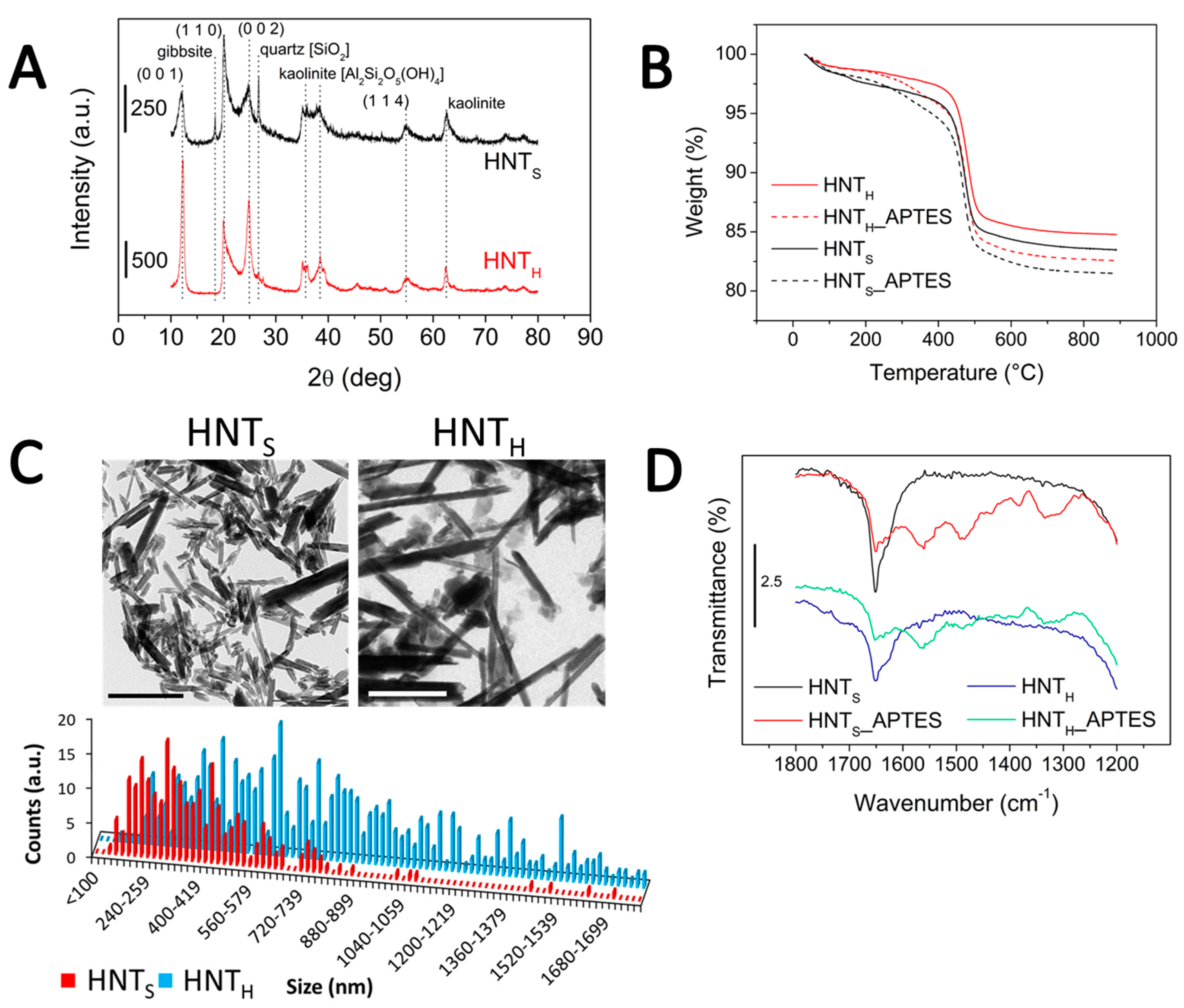
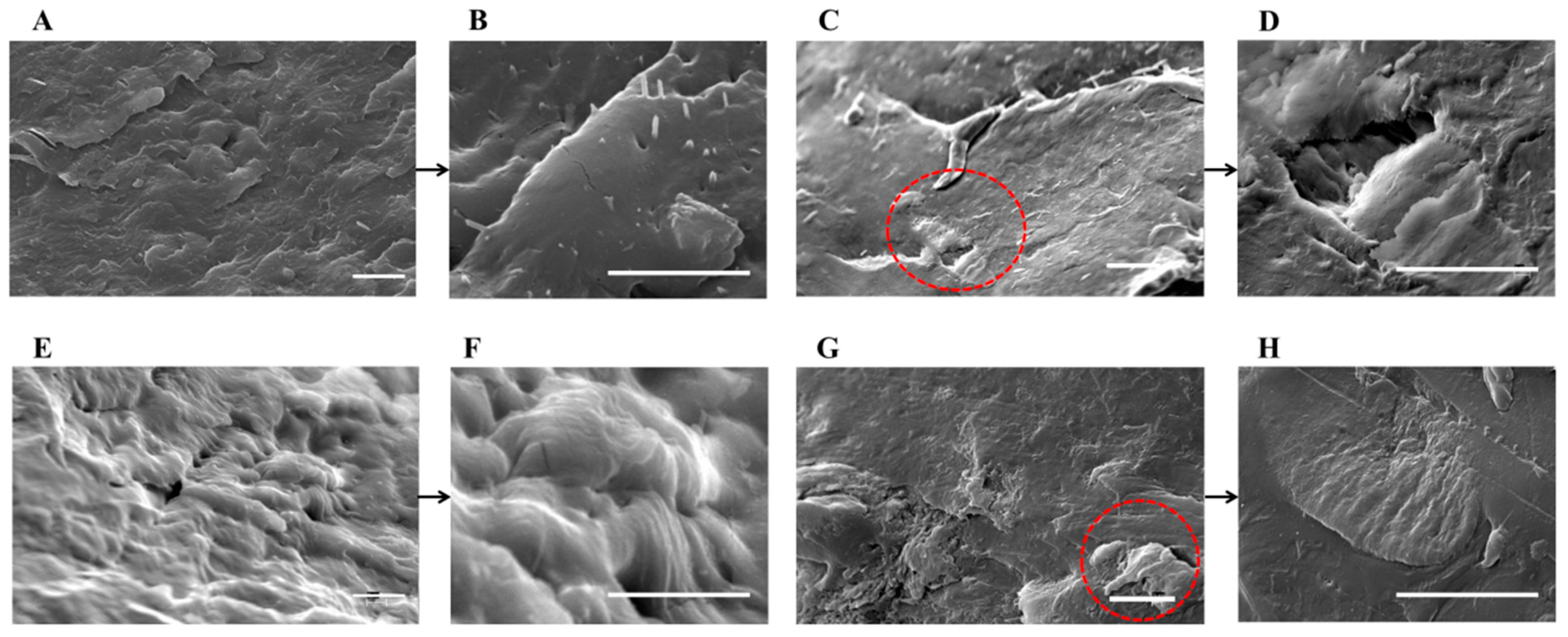
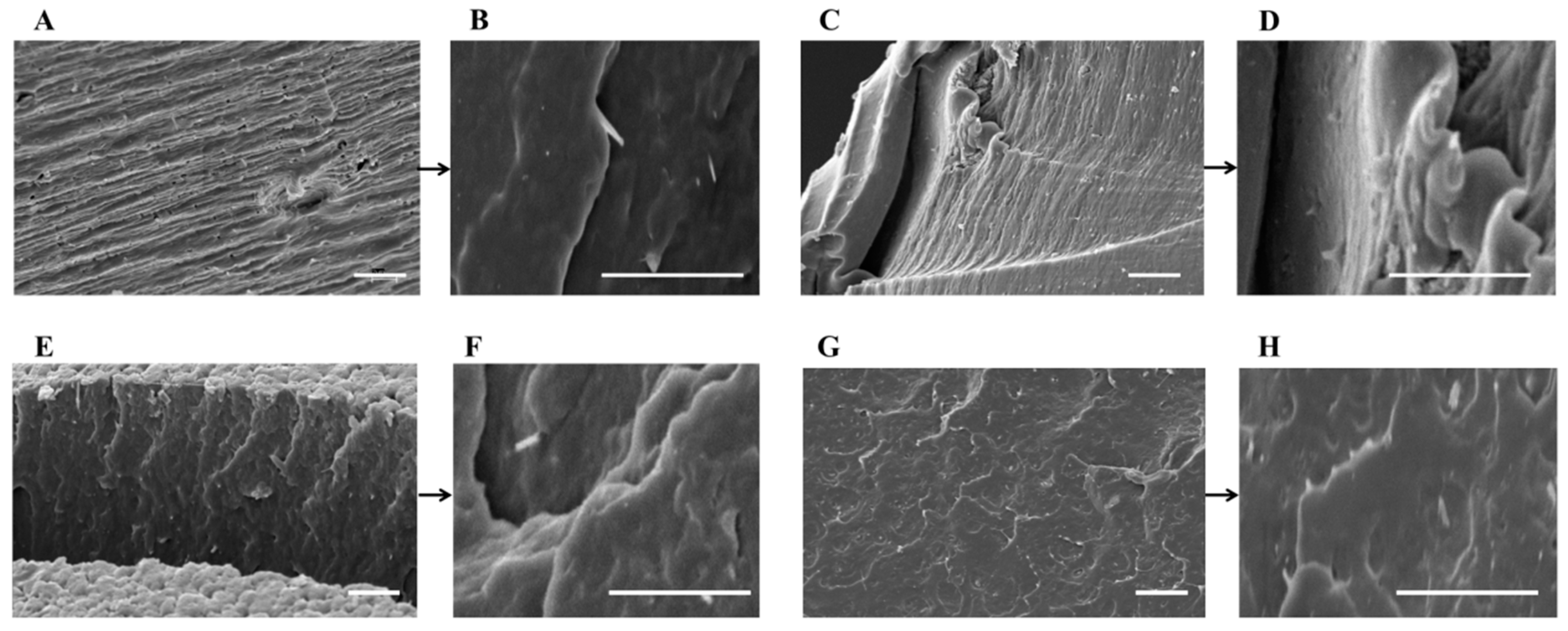
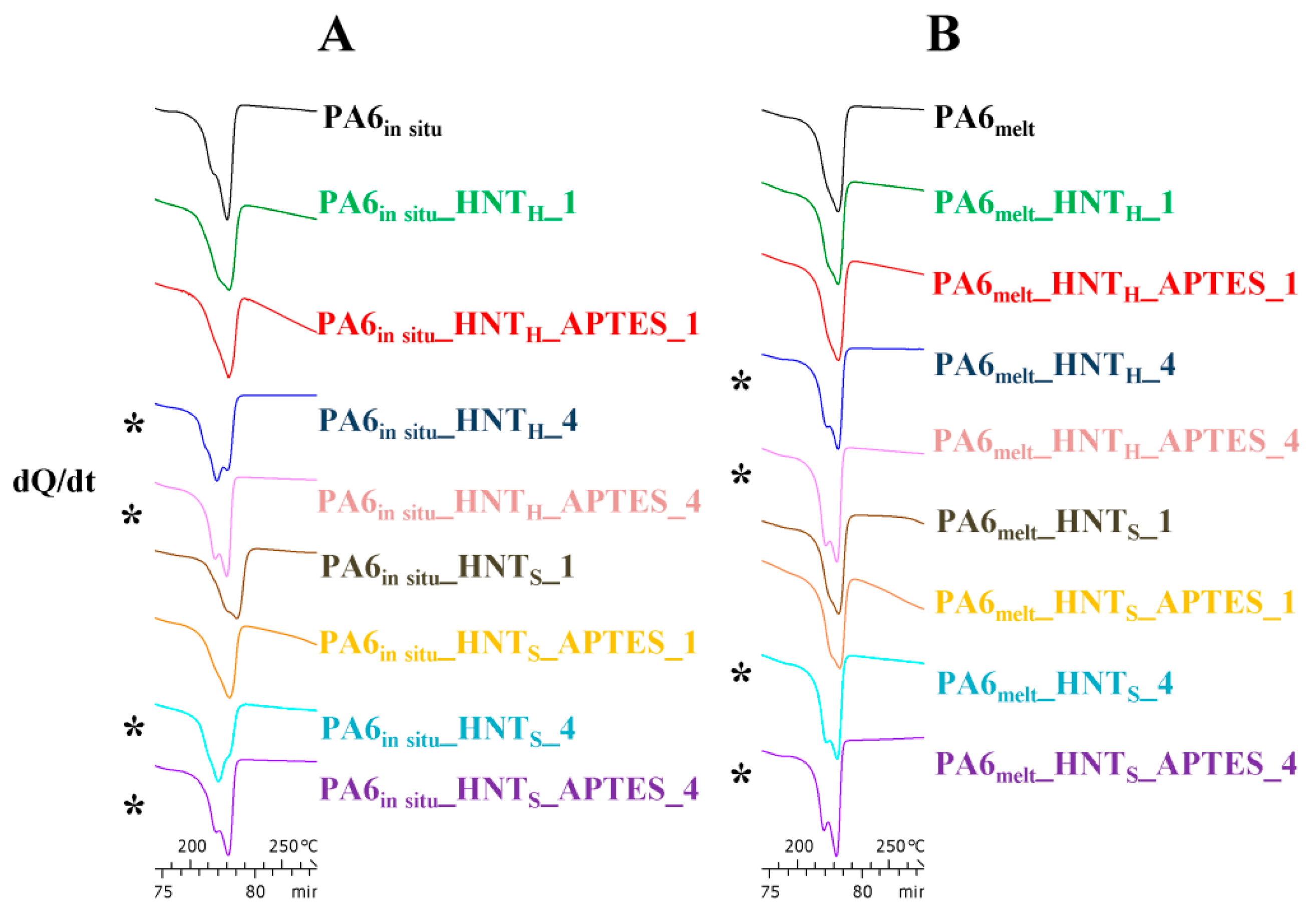
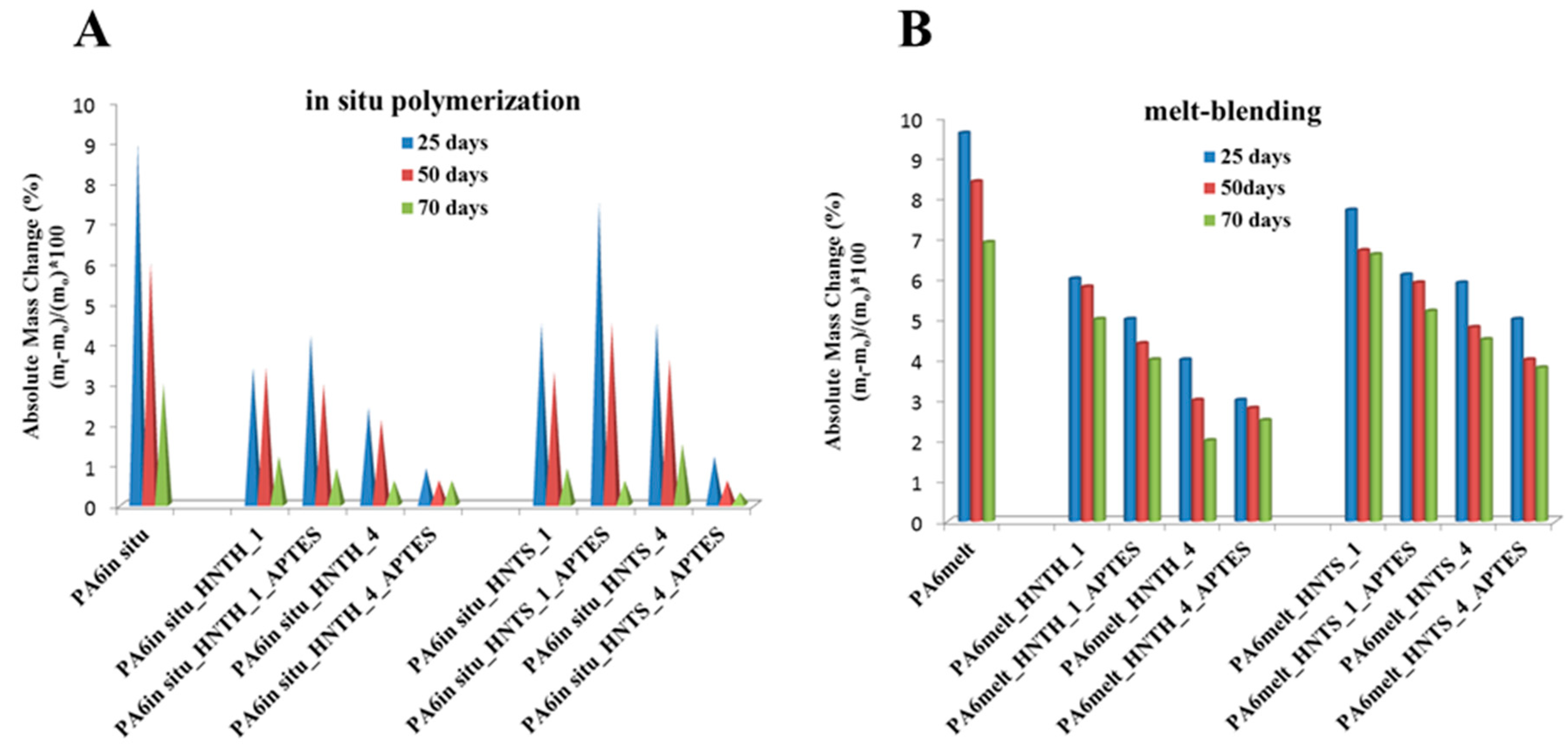
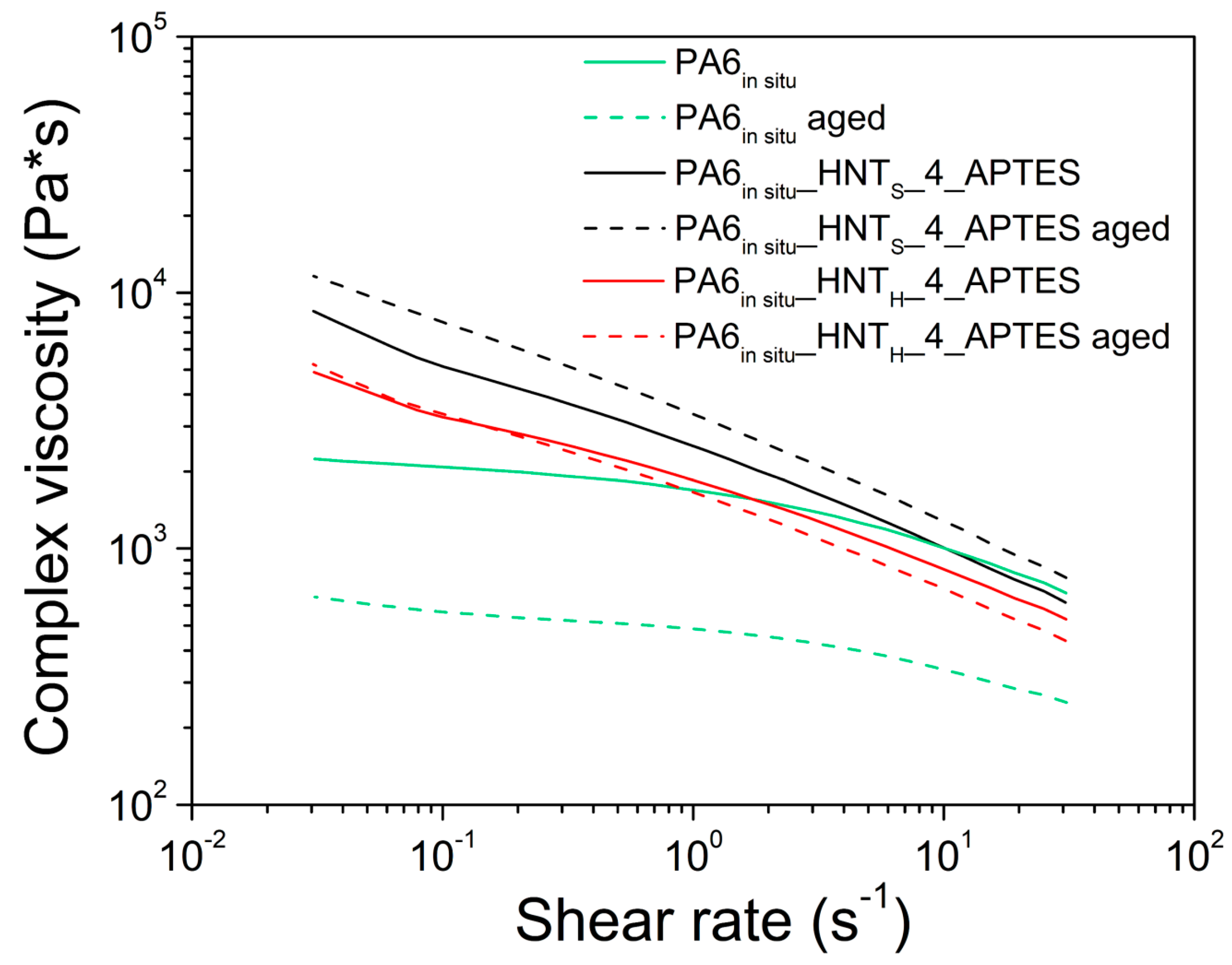
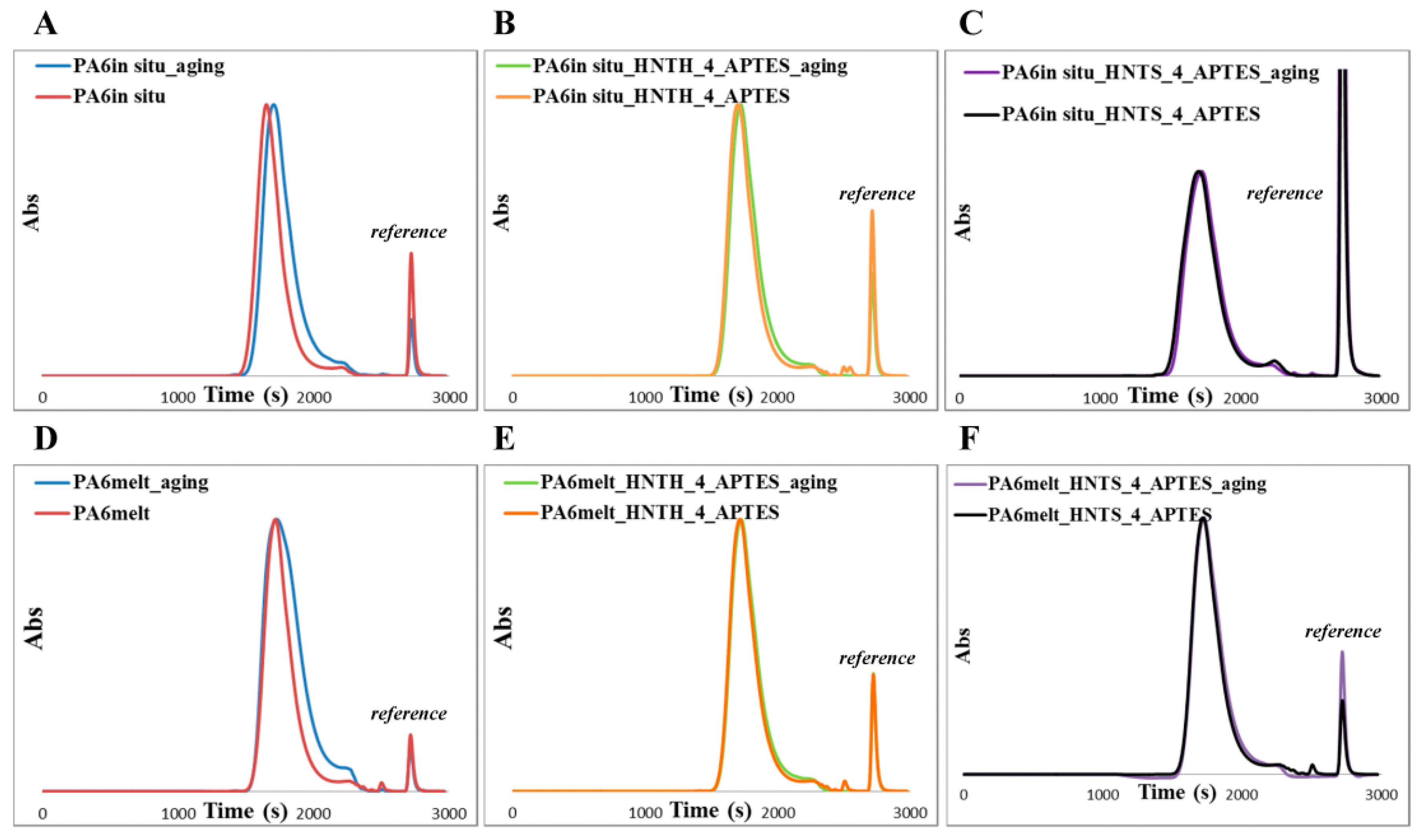
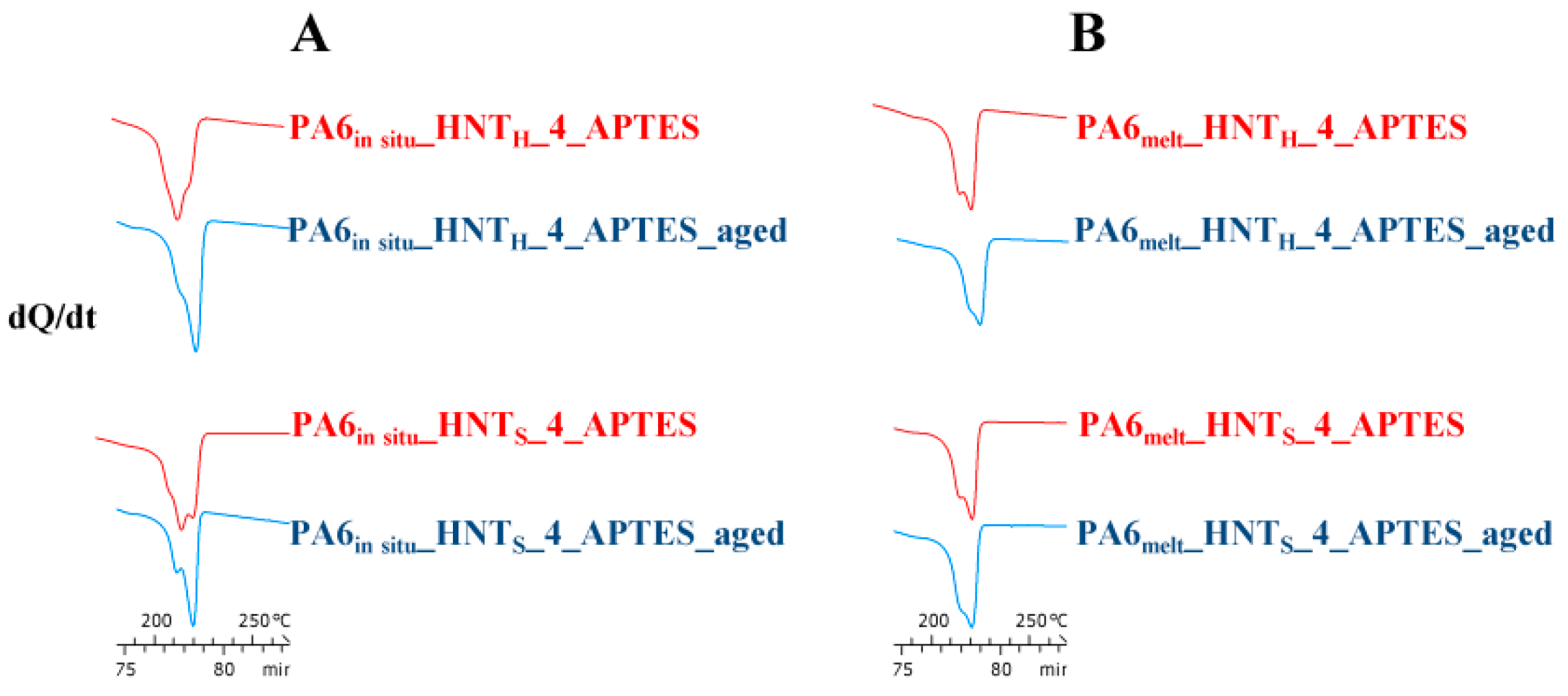
| Sample | SSA (m2/g) | Avg. Length (nm) | Avg. Aspect Ratio | ς-Potential (Bare HNT) (mV) | ς-Potential (HNT_APTES) (mV) | APTES Loading (%) |
|---|---|---|---|---|---|---|
| HNTS | 53 | 400 ± 300 | 5 ± 3 | −31 ± 2 | +5.9 ± 0.6 | 4.6 |
| HNTH | 34 | 1100 ± 800 | 15 ± 9 | −59 ± 3 | −44 ± 2 | 5.1 |
| Preparation Route | Sample | HNTtheoretical (% w/w) | HNTreal (% w/w) | Avrami Data | ||
|---|---|---|---|---|---|---|
| onset Tc (°C) | n | t1/2 (s) | ||||
| In situ polymerization | PA6in situ | - | - | 190 | 1.6 | 63 |
| 199 | 1.8 | 408 | ||||
| PA6in situ_HNTH_1 | 1 | 0.8 | 190 | 1.0 | 135 | |
| PA6in situ_HNTS_1 | 1 | 0.9 | 199 | 2.3 | 408 | |
| PA6in situ_HNTH_4 | 4 | 3.3 | 190 | 1.1 | 163 | |
| PA6in situ_HNTS_4 | 4 | 4.0 | 199 | 1.6 | 408 | |
| PA6in situ_HNTH_1_APTES | 1 | 0.7 | 190 | 1.0 | 137 | |
| PA6in situ_HNTS_1_APTES | 1 | 1.0 | 199 | 2.4 | 420 | |
| PA6in situ_HNTH_4_APTES | 4 | 4.0 | 190 | 1.2 | 174 | |
| PA6in situ_HNTS_4_APTES | 4 | 3.9 | 199 | 1.6 | 408 | |
| Melt extrusion | PA6melt | - | - | 200 | 1.8 | 135 |
| PA6melt_HNTH_1 | 1 | 1.0 | 200 | 2.3 | 135 | |
| PA6melt_HNTS_1 | 1 | 0.6 | 200 | 2.6 | 135 | |
| PA6melt_HNTH_4 | 4 | 4.0 | 200 | 2.3 | 135 | |
| PA6melt_HNTS_4 | 4 | 4.0 | 200 | 2.1 | 135 | |
| PA6melt_HNTH_1_APTES | 1 | 0.8 | 200 | 2.3 | 126 | |
| PA6melt_HNTS_1_APTES | 1 | 0.7 | 200 | 2.1 | 126 | |
| PA6melt_HNTH_4_APTES | 4 | 3.8 | 200 | 2.0 | 135 | |
| PA6melt_HNTS_4_APTES | 4 | 3.6 | 200 | 2.0 | 135 | |
| Sample | Cooling | 2nd Heating | |
|---|---|---|---|
| Tc (°C) | Tm (°C) | χc (%) | |
| PA6in situ | 188.1 | 220.8 | 30.2 |
| PA6in situ_HNTH_1 | 187.2 | 220.8 | 23.8 |
| PA6in situ_HNTS_1 | 185.5 | 220.4 | 22.3 |
| PA6in situ_HNTH_4 | 182.1 | 219.0 | 23.5 |
| PA6in situ_HNTS_4 | 182.2 | 219.1 | 22.4 |
| PA6in situ_HNTH_1_APTES | 187.2 | 220.3 | 21.5 |
| PA6in situ_HNTS_1_APTES | 187.0 | 220.3 | 18.3 |
| PA6in situ_HNTH_4_APTES | 184.6 | 214.6 | 14.0 |
| PA6in situ_HNTS_4_APTES | 185.0 | 214.4 | 14.9 |
| PA6melt | 189.4 | 221.1 | 24.9 |
| PA6melt_HNTH_1 | 188.8 | 221.2 | 20.1 |
| PA6melt_HNTS_1 | 188.9 | 221.6 | 24.3 |
| PA6melt_HNTH_4 | 186.2 | 220.1 | 17.1 |
| PA6melt_HNTS_4 | 185.9 | 220.4 | 21.8 |
| PA6melt_HNTH_1_APTES | 188.6 | 221.4 | 24.4 |
| PA6melt_HNTS_1_APTES | 188.4 | 221.4 | 26.3 |
| PA6melt_HNTH_4_APTES | 187.1 | 219.8 | 21.7 |
| PA6melt_HNTS_4_APTES | 188.3 | 219.6 | 19.3 |
| Sample | SECunaged | SECaged | ||
|---|---|---|---|---|
| D | D | |||
| PA6in situ | 57,200 | 2.1 | 45,800 | 2.4 |
| PA6in situ_HNTH_1 | 48,600 | 2.1 | 32,400 | 2.5 |
| PA6in situ_HNTS_1 | 56,700 | 2.1 | 49,300 | 2.5 |
| PA6in situ_HNTH_4 | 60,400 | 2.0 | 42,000 | 2.2 |
| PA6in situ_HNTS_4 | 62,600 | 2.1 | 50,300 | 2.6 |
| PA6in situ_HNTH_1_APTES | 55,600 | 2.1 | 45,400 | 2.4 |
| PA6in situ_HNTS_1_APTES | 54,600 | 2.2 | 49,900 | 2.6 |
| PA6in situ_HNTH_4_APTES | 47,800 | 2.3 | 41,800 | 2.3 |
| PA6in situ_HNTS_4_APTES | 60,600 | 2.3 | 59,000 | 2.3 |
| PA6melt | 43,600 | 1.9 | 33,100 | 2.2 |
| PA6melt_HNTH_1 | 40,300 | 2.0 | 19,300 | 2.5 |
| PA6melt_HNTS_1 | 40,400 | 2.0 | 19,700 | 2.5 |
| PA6melt_HNTH_4 | 42,400 | 2.0 | 21,000 | 2.3 |
| PA6melt_HNTS_4 | 42,300 | 2.0 | 22,100 | 2.3 |
| PA6melt_HNTH_1_APTES | 40,400 | 2.0 | 33,100 | 2.2 |
| PA6melt_HNTS_1_APTES | 39,700 | 1.9 | 22,300 | 2.2 |
| PA6melt_HNTH_4_APTES | 42,500 | 2.0 | 42,000 | 2.0 |
| PA6melt_HNTS_4_APTES | 39,900 | 2.0 | 39,800 | 2.0 |
© 2020 by the authors. Licensee MDPI, Basel, Switzerland. This article is an open access article distributed under the terms and conditions of the Creative Commons Attribution (CC BY) license (http://creativecommons.org/licenses/by/4.0/).
Share and Cite
Sabatini, V.; Taroni, T.; Rampazzo, R.; Bompieri, M.; Maggioni, D.; Meroni, D.; Ortenzi, M.A.; Ardizzone, S. PA6 and Halloysite Nanotubes Composites with Improved Hydrothermal Ageing Resistance: Role of Filler Physicochemical Properties, Functionalization and Dispersion Technique. Polymers 2020, 12, 211. https://doi.org/10.3390/polym12010211
Sabatini V, Taroni T, Rampazzo R, Bompieri M, Maggioni D, Meroni D, Ortenzi MA, Ardizzone S. PA6 and Halloysite Nanotubes Composites with Improved Hydrothermal Ageing Resistance: Role of Filler Physicochemical Properties, Functionalization and Dispersion Technique. Polymers. 2020; 12(1):211. https://doi.org/10.3390/polym12010211
Chicago/Turabian StyleSabatini, Valentina, Tommaso Taroni, Riccardo Rampazzo, Marco Bompieri, Daniela Maggioni, Daniela Meroni, Marco Aldo Ortenzi, and Silvia Ardizzone. 2020. "PA6 and Halloysite Nanotubes Composites with Improved Hydrothermal Ageing Resistance: Role of Filler Physicochemical Properties, Functionalization and Dispersion Technique" Polymers 12, no. 1: 211. https://doi.org/10.3390/polym12010211
APA StyleSabatini, V., Taroni, T., Rampazzo, R., Bompieri, M., Maggioni, D., Meroni, D., Ortenzi, M. A., & Ardizzone, S. (2020). PA6 and Halloysite Nanotubes Composites with Improved Hydrothermal Ageing Resistance: Role of Filler Physicochemical Properties, Functionalization and Dispersion Technique. Polymers, 12(1), 211. https://doi.org/10.3390/polym12010211









